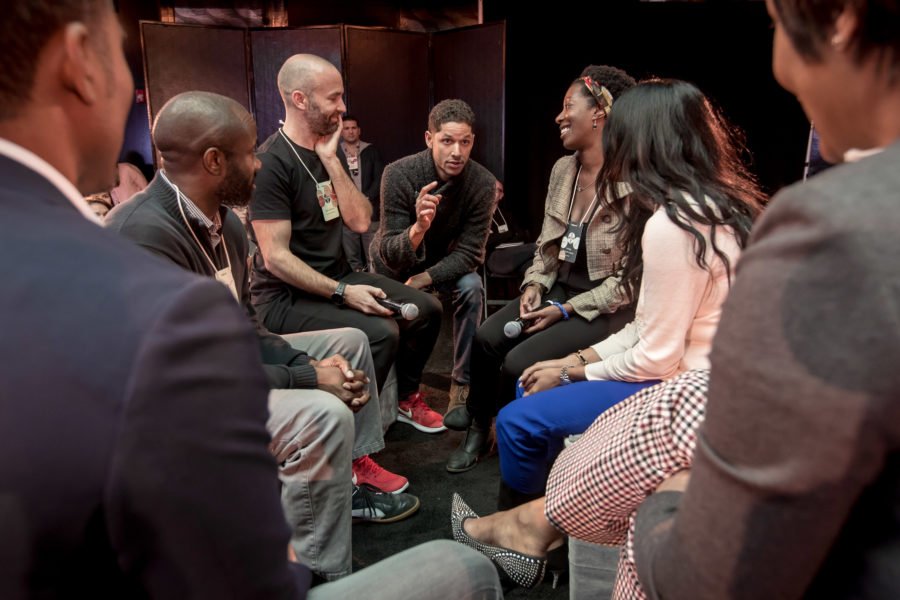9 Ways to Make Work More Human
Brooklyn attendees of the Life@Work conference meditated, went to Mars, swapped stories about status, and brainstormed to make connections
Participants in the Life@Work conference huddled last week in Brooklyn (Photos by Gary He, courtesy of Life@Work)
Employees are not robots.
You’d be forgiven for thinking otherwise. Consider how we interact in the workplace: same desk, same emails, same hierarchy, same company line. You’re not supposed to rock the boat; usually, you’re not supposed to acknowledge you’re even in a boat.
It doesn’t have to be this way, according to Life@Work, a company culture conference that descended last week at Brooklyn’s 501 Union, the light-filled event space and enviable wedding venue. During two days of panels, some movement exercises, and a smidge of group meditation, attendees from innovative companies like the Obama Foundation, Kickstarter, Google, Buzzfeed, and more attempted to “create a place for genuine connection,” in the words of Brad Lande-Shannon, CEO at Live Grey, the culture consultancy business behind the event. So why this borough? “Brooklyn is a creative heartbeat,” he told The Bridge, “and the environmental context of where you do something is important.”
“One word we want to get across to people is that vulnerability is a strength,” he says, and the gathered HR professionals, engineers, organizational designers, and other leaders in charge of company culture did get vulnerable, with the intention to take these ideas back to their workplace. But anyone who wants to improve the state of their office can benefit from this advice. One tip to start: Turn off your phone more often. They weren’t welcome during the conference because, in case you’ve noticed, those little devices can hijack your attention. Nine takeaways:
Head to Mars with your team
Well, not literally. Unless you’re Elon Musk. But attendees pretended to visit the Red Planet during a game called Mars 2100: A Future of Work Simulation by The Ready. Settlers of Catan fans would appreciate the immersive new game, which premiered at the conference, led by founder Aaron Dignan. Turns out humans didn’t do a great job managing our own planet, so they need to build a new community. Players are given different skill sets and asked to collaborate when, say, an ice storm wipes out the crop supply. Team building and communication are key, and after playing for an hour, one person remarked that the game simulated work meetings. Except here, if you didn’t speak up, there were bigger consequences than a missed deadline: you could be sabotaging humanity’s hope for the future.
Define your personal needs
Everyone has certain fundamental needs, said Erinn Cerreta-Bartko and Joseph White from Herman Miller, who work at the interaction of strategy and design. The problem at work comes when we ignore individual needs—autonomy, security, belonging, achievement, status, and purpose—in favor of group needs. The trick is keeping them in balance. If you feel unhappy at work, it could be because your personal purpose and your organization’s purpose are at a crossroads, rather than fueling one another.

Participants in the conference were required to go offline; no cellphones allowed
Disarm yourself at work
Here’s one way of changing up your 9-to-5: look deep into the eyes of your cubicle mate. If that makes you uncomfortable, then maybe you should try it, says Nita Baum, founder of freelancer community b*free, as she led exercises intended to disarm attendees, including, yes, staring at the stranger next to you, and thinking about your favorite activities as a child. You know, the ones you indulged in before shame or fear or criticism. The idea was that feeling vulnerable in the moment or reconnecting to those activities could unlock a new source of creativity at work.
Don’t be afraid of feedback
You can read a million articles, but how do you really build a culture-first company? Didier Elzinga, founder of Culture Amp, a culture-analytics platform, said it’s all about acting on employee feedback. A company that doesn’t first define its values—meaning its thoughts on compassion, vulnerability, awareness, community, resilience—can’t expect employees to pick up the slack.
Jump into challenges
“Think about a high-growth time for you,” said Andy Fleming, the CEO of Way to Grow Inc., which blends adult developmental psychology with real-world applications. (Attendees then had to share their high-growth time with their neighbor.) Fleming pointed out that this growth spurt likely came after being thrown into a task for which you weren’t fully prepared or qualified. “High growth comes from attacking challenges,” he said, “and then they’re like happy accidents.” So if you’re feeling stagnant at work, you might actually need more of a challenge. Burnout rarely comes from working long hours, he said, and actually comes from not experiencing growth.
Bring culture into work
Airbnb gives employees $500 a quarter to travel … on Airbnb, of course. That’s one way the Silicon Valley unicorn fosters a strong sense of belonging. “We don’t want the mercenaries, we want the missionaries,” said Mark Levy, global head of employee experience at Airbnb, who also said that on the first Thursday of the month, employees can teach their coworkers about their favorite hobby in an attempt to bring their outside-work life into work. But employers must also be mindful that “culture is not static,” said Carissa Melendez, v.p. of people and workplace at the Brooklyn-based Etsy. The company set a goal to increase diversity from underrepresented backgrounds, and now interviews at least two diverse candidates for each open position.
Banish LOMO
Are you still at your job because of emotional pressure, economic pressure, or inertia? Those are all indirect motives for being at work, said Neel Doshi, co-founder of Vega Factor, a New York-based firm dedicated to ending low-performing cultures, and they can contribute to LOMO—low total motivation. (Finally, something more relatable than FOMO!) When you’re checking the boxes and not adapting at work, you’re more inclined to be distracted or even face writer’s block. “Why we work determines how well we work,” said Doshi, and the first step starts with asking why you’re doing the job you have now.
Act Like a CEO
Adam Bryant knows CEOs. As an author and creator of the New York Times’ Corner Office column, he has interviewed thousands of high performers about leadership lessons. Bryant said he’s noticed some common qualities among them, including applied curiosity, relentless questioning, and always taking the harder path. “I’m drawn to the fire,” one CEO told him. He also shared an interviewing tip that’s helpful in the workplace: “It’s more important to be interested rather than interesting.”
Always go offline
One of the most notable aspects of the conference was how open and eager everyone seemed to be (the name tags helped). Lande-Shannon said he wanted to bring communities together offline for a “shock to the system,” and to recharge with new ideas—kind of like a mega, multi-company offsite. The culture movement continues. They’ve got three conferences planned: San Francisco in March, Los Angeles in June, and, of course, back to Brooklyn, the epicenter of creative workplaces, next year. But first … back to work.













